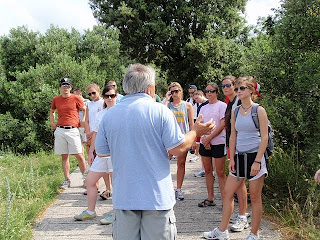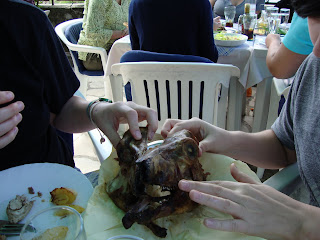
 Colin: Each of us came to Croatia with different ideas of what we would find and I am sure we all are leaving with experiences that are different than we expected. I came to Croatia expecting to find a country still mostly involved in an Eastern Bloc economic model, and what I found was a tourist-based market economy. I expected to find a socialized medical system, and to a large extent this still exists, but Croatia is currently going through health insurance reform that is moving them away from a completely state-controlled system. I expected to find a combination of state-run industries and small rural farms, but what I found was an aging rural population (the youth has mostly moved to the cities for work), and a "touristic" economy where the majority of the annual income is earned from German and Italian tourists between July and September. The rest of the year people just get by in any way they can. I expected to find a country with a long and interesting history, and what I found was partly this, but also was a people looking for a unique cultural identity. It is less than 20 years that Croatia has had a truly independent history that was not tied to Yugoslav, Austro-Hungarian, Ottoman, Venician, or Roman influences. This is most obvious in the facts that the 1991-96 war is commonly referred to as the "Independence War" and that in our travels through 'Hrvatska' it seemed sometimes like you could throw a stick and almost be guaranteed to hit a sociologist looking to help define things as being significantly culturally Croatian (not something I objected to mind you, my own training being as a sociologist and demographer originally...)
Colin: Each of us came to Croatia with different ideas of what we would find and I am sure we all are leaving with experiences that are different than we expected. I came to Croatia expecting to find a country still mostly involved in an Eastern Bloc economic model, and what I found was a tourist-based market economy. I expected to find a socialized medical system, and to a large extent this still exists, but Croatia is currently going through health insurance reform that is moving them away from a completely state-controlled system. I expected to find a combination of state-run industries and small rural farms, but what I found was an aging rural population (the youth has mostly moved to the cities for work), and a "touristic" economy where the majority of the annual income is earned from German and Italian tourists between July and September. The rest of the year people just get by in any way they can. I expected to find a country with a long and interesting history, and what I found was partly this, but also was a people looking for a unique cultural identity. It is less than 20 years that Croatia has had a truly independent history that was not tied to Yugoslav, Austro-Hungarian, Ottoman, Venician, or Roman influences. This is most obvious in the facts that the 1991-96 war is commonly referred to as the "Independence War" and that in our travels through 'Hrvatska' it seemed sometimes like you could throw a stick and almost be guaranteed to hit a sociologist looking to help define things as being significantly culturally Croatian (not something I objected to mind you, my own training being as a sociologist and demographer originally...)One of my professional interests in this trip was to look at the integrated health care delivery system as practiced in Croatia. What I found was a "whole health" model of health-care delivery where mind, body, and spirit are integrated in a holistic understanding of the needs of the individual and an acknowledgment of the power of social networks in the health of all people.
Another of my interest was to get an idea of how Croatia was preparing for the forthcoming ascension to EU membership and what the expected impact would be not only on the delivery of health care services but also infrastructure of the country. In talks with many of the junior researchers, guides, merchants, and service employees that I met on our excursions and in the off-time I have come to believe that, while the official governmental line is that EU membership may cause minor short-term hardship for the working population and is good for Croatian long-term economic well-being, the majority of the population does not have the same optimistic view of social and political integration with the European Union, especially in light of the current economic problems in Greece and Hungary.
What I found here was an amazingly generous people who, as Sasa explained to us, are at the cross roads of Europe -- part East/part West; part Central European/part Mediterranean; part planned economy/part free market; part urban/part rural; and part mountain/part coastal. If there is one thing that this trip -- from Central Croatia to Slavonia to Istria to Dalmacija -- has shown us, is that for something to be typically "Croatian" it is to be a product of multiple influences and sources. There is an assumption in the U.S. that to be Croat is to be ethnically and socially homogeneous. The wealth of diversity that we have seen on this trip shows me that is farthest from the truth!
Charlotte: This trip was truly an amazing experience. This was my first trip abroad and I am not really sure what I expected but I feel like I learned a lot on this trip. Everyone I met in Croatia was very welcoming and they were very hospitable. I feel like our group defiantly stuck out as foreigners but we were greeted politely especially in the smaller towns. I also really admired Croats because most of the young people were bilingual and very cultured. The trip is over but I feel like I am still taking in this experience and making connections for a well rounded over all view of abroad as well.
From a health aspect, it was obvious that we share some of the same health problems as Croatia, these health issues go along with the four priorities for health care in Croatia: decreasing smoking, increase healthy eating, increasing exercise, and increasing knowledge of sexually transmitted infections. It was obvious that smoking is a major health issue in Croatia everywhere we went people were smoking even the very young teens were partaking in this unhealthy habit. I also noticed that a majority of our meals were meat and potatoes with lots of salt and bread with every meal. The entire three and a half weeks we were here we only saw one gym and I did not see anyone else exercising. It appeared that Croats live a relaxed life socializing at cafes for hours at a time; I think increasing exercise will help them in every aspect of their lives. The fourth health priority in Croatia is increasing knowledge on sexually transmitted infections. From the doctors that we spoke with STI’s are not a problem but increasing knowledge will insure that this health issue does not become a problem. While we have some of the same health, problems that Croatia there is not easy answer to fix them. I think we can learn from their education programs and adapt them to our country for example, their sex education, and STI prevention education that are in place in health classes for 12 and 13 year olds. Croatia implements a comprehensive sex education at this age.
From a health aspect, it was obvious that we share some of the same health problems as Croatia, these health issues go along with the four priorities for health care in Croatia: decreasing smoking, increase healthy eating, increasing exercise, and increasing knowledge of sexually transmitted infections. It was obvious that smoking is a major health issue in Croatia everywhere we went people were smoking even the very young teens were partaking in this unhealthy habit. I also noticed that a majority of our meals were meat and potatoes with lots of salt and bread with every meal. The entire three and a half weeks we were here we only saw one gym and I did not see anyone else exercising. It appeared that Croats live a relaxed life socializing at cafes for hours at a time; I think increasing exercise will help them in every aspect of their lives. The fourth health priority in Croatia is increasing knowledge on sexually transmitted infections. From the doctors that we spoke with STI’s are not a problem but increasing knowledge will insure that this health issue does not become a problem. While we have some of the same health, problems that Croatia there is not easy answer to fix them. I think we can learn from their education programs and adapt them to our country for example, their sex education, and STI prevention education that are in place in health classes for 12 and 13 year olds. Croatia implements a comprehensive sex education at this age.














































